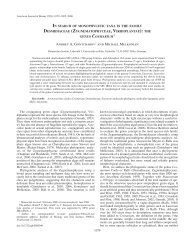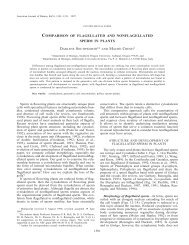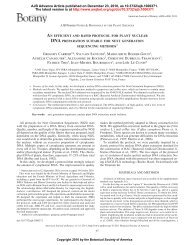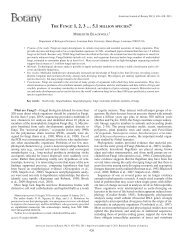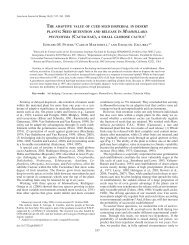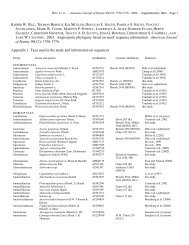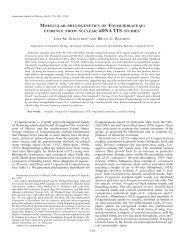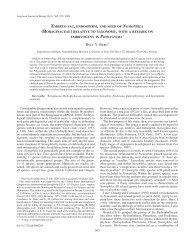View - American Journal of Botany
View - American Journal of Botany
View - American Journal of Botany
Create successful ePaper yourself
Turn your PDF publications into a flip-book with our unique Google optimized e-Paper software.
1292 AMERICAN JOURNAL OF BOTANY<br />
[Vol. 86<br />
medeae and thus was not primarily concerned with generic limits. However,<br />
most <strong>of</strong> the genera within the tribe have been monographed and<br />
their monophyly is supported by morphological synapomorphies (Judd<br />
1981, 1982, 1984, 1986, 1995b). As discussed in Kron and Judd (1997;<br />
see also Weins, 1998) supraspecific taxa (i.e., genera and sections) were<br />
represented by particular species.<br />
Character scorings for most <strong>of</strong> the 60 phenotypic characters (i.e.,<br />
morphological, anatomical, and embryological—for convenience hereafter<br />
merely referred to as morphological characters) (Table 2) are based<br />
on the authors’ observations <strong>of</strong> herbarium material and, where possible,<br />
living material, supplemented by revisionary and monographic studies<br />
(see references cited above). Character scorings relating to chromosome<br />
number and chemical features mainly were taken from the literature<br />
(see Table 3).<br />
Most morphological characters were readily divisible into discrete<br />
states, thus avoiding arbitrary decisions relating to state delimitation<br />
(Stevens, 1991). A few problems are noted in Table 3. Some characters<br />
could not be included in the analyses because they showed too much<br />
infrataxon variation or could not be delimited into discrete states, e.g.,<br />
leaf size, inflorescence structure, bracteole position, calyx size, corolla<br />
shape and size, fruit shape, and placenta position. All multistate characters<br />
were considered to be unordered (Table 2). Species varying in<br />
particular characters were scored as ‘‘?’’ (and indicated as ‘‘variable’’<br />
in Table 3).<br />
Total DNA was extracted from fresh or silica-gel dried (Chase and<br />
Hills, 1991) leaves using the modified CTAB (hexadecyltrimethylammonium<br />
bromide) procedure <strong>of</strong> Doyle and Doyle (1987). The matK<br />
gene <strong>of</strong> the chloroplast DNA was amplified by the polymerase chain<br />
reaction (PCR) via the methods described in Olmstead et al. (1992)<br />
using the same parameters as described in Kron et al. (1999). Primer<br />
sequences from Johnson and Soltis (1994, 1995) and Steele and Vilgalys<br />
(1994) were used for matK PCR and sequencing. For the rbcL<br />
gene, primers and PCR protocols followed those <strong>of</strong> Olmstead et al.<br />
(1992). Amplified products were cleaned using Microcon 100 filter<br />
tubes (Fisher Scientific, Atlanta, Georgia). The nucleotide sequencing<br />
was performed at the Wake Forest School <strong>of</strong> Medicine, DNA Core<br />
Laboratory on an ABI 377 Automated DNA Sequencer (Perkin-Elmer,<br />
Foster City, California). Raw sequences (for both rbcL and matK) were<br />
edited using Sequencher 3.0 (Gene Codes Corp., Ann Arbor, Michigan).<br />
The edited sequences were visually aligned.<br />
Voucher information for all taxa sampled in this study can be obtained<br />
from KAK. All sequences can be obtained through GenBank<br />
(Table 1).<br />
Phylogenetic analyses—Analyses <strong>of</strong> morphological data included<br />
representatives <strong>of</strong> outgroups identified as appropriate based on previous<br />
studies (Judd and Kron, 1993; Kron and Chase, 1993; Kron, 1996,<br />
1997; Kron and Judd, 1997). Enkianthus campanulatus, Sprengelia incarnata,<br />
and Prionotes cerinthoides were used as outgroups. [Harrimanella<br />
(used in the molecular analyses) was not used as an outgroup<br />
taxon because its very different morphology makes determining character<br />
homology difficult.] Analyses <strong>of</strong> the morphological data were<br />
rooted with Enkianthus, allowing the remaining outgroup taxa to resolve<br />
simultaneously with the ingroup taxa. The analyses employed the<br />
branch-and-bound algorithm (ie-) with extended branch swapping (bb*)<br />
<strong>of</strong> the Hennig86, version 1.5, computer s<strong>of</strong>tware developed by Farris<br />
(1988), and the branch-and-bound option <strong>of</strong> PAUP (Phylogenetic Analysis<br />
Using Parsimony) 3.1.1. (Sw<strong>of</strong>ford, 1993).<br />
As in the morphological study, analysis <strong>of</strong> molecular data (rbcL and<br />
matK nucleotide sequences) included representatives <strong>of</strong> outgroups identified<br />
as appropriate based on previous studies (Judd and Kron, 1993;<br />
Kron and Chase, 1993) and also on the basis <strong>of</strong> preliminary analysis <strong>of</strong><br />
larger matK and rbcL data sets (Kron et al., 1999). These indicate appropriate<br />
potential outgroups as Enkianthus campanulatus, Harrimanella<br />
hypnoides, Sprengelia incarnata, and Prionotes cerinthoides; the<br />
latter two represent the epacrid clade (see Kron, 1997). Analyses <strong>of</strong> the<br />
molecular data were run with Enkianthus designated as the outgroup,<br />
allowing the remaining outgroup taxa to resolve simultaneously with<br />
the ingroup taxa. The few indels that occurred were treated as missing<br />
data. All characters were weighted equally in all analyses. The analyses<br />
were run using the heuristic search option (MULPARS, TBR, 1000<br />
random replicates) <strong>of</strong> PAUP 3.1.1 (Sw<strong>of</strong>ford, 1993). Three measures <strong>of</strong><br />
internal support were used to assess clade robustness when appropriate:<br />
parsimony jackknife (Farris et al., 1996) bootstrap (100 random replicates,<br />
both analyses) and decay (Autodecay 3.0; Mishler, Donoghue,<br />
and Albert, 1991; Eriksson and Wikstrom, 1995).<br />
Combined parsimony analyses (1000 random replicates, MULPARS,<br />
TBR) based on rbcL matK nucleotide sequences, and rbcL matK<br />
morphological data were performed using Enkianthus campanulatus,<br />
Prionotes cerinthoides, and Sprengelia incarnata, as outgroup taxa (and<br />
analysed by PAUP 3.1.1). Bootstrap (100 replicates) and decay analyses<br />
were performed to assess internal support for relationships obtained in<br />
the heuristic analyses.<br />
RESULTS<br />
Morphological data—The morphological analyses<br />
(Hennig86 and PAUP 3.1.1) resulted in the generation <strong>of</strong><br />
36 equally parsimonious trees <strong>of</strong> 139 steps, a consistency<br />
index (CI) <strong>of</strong> 0.48, and a retention index (RI) <strong>of</strong> 0.68.<br />
The topologies represented in these trees, however, are<br />
all quite similar, differing mainly in the placement <strong>of</strong> Andromeda<br />
and a few members <strong>of</strong> the Gaultheria group.<br />
The strict consensus (Fig. 1) and a representative cladogram<br />
(Fig. 2) are presented.<br />
Oxydendrum consistently is the sister group to all other<br />
ingroup taxa, which are are united on the basis <strong>of</strong> their<br />
inflorescences developing on shoots <strong>of</strong> the previous season<br />
(character no. 22) and the pedicel articulated with the<br />
flower (no. 26). Oxydendrum is quite distinctive because<br />
<strong>of</strong> its Calluna-type pith (no. 2-2), deciduous leaves (no.<br />
10-0), and flowers in which all traces to the floral organs<br />
leave the elongated floral axis separately (Palser, 1952).<br />
The monophyly <strong>of</strong> Vaccinieae (as represented by Vaccinium<br />
macrocarpon, V. meridionale, and Satyria warszewiczii)<br />
is supported by their inferior ovary (no. 46)<br />
and indehiscent fruit (no. 51-2), and this group is represented<br />
in most trees. Fleshy fruits (no. 49) are also synapomorphic<br />
for these species under a DELTRAN (see<br />
Wiley et al. [1991] for discussion <strong>of</strong> ACCTRAN and<br />
DELTRAN) optimization. However, Tepuia sometimes is<br />
placed within this clade, while in other trees it links with<br />
Diplycosia because they share apical connate bracteoles<br />
(no. 25) and methyl salicylate (no. 58). The Diplycosia<br />
Tepuia clade, when present, may be sister to Vaccinieae<br />
(Fig. 2), due, in part, to their anther tubules (no.<br />
41), or placed elsewhere in the tree, but these species are<br />
always phylogenetically adjacent to members <strong>of</strong> Vaccinieae.<br />
Thus, in the strict consensus tree (Fig. 1) the<br />
monophyly <strong>of</strong> Vaccinieae is not evident.<br />
Several genera, i.e., Pieris, Lyonia, Agarista, and<br />
Gaultheria s.l., are consistently indicated as monophyletic.<br />
The monophyly <strong>of</strong> Pieris is supported by the inflorescence<br />
exposed during the winter (no. 23) and valvate<br />
calyx lobes (no. 27). Paired appendages located at the<br />
anther–filament junction (no. 39-1) are also synapomorphic<br />
under a DELTRAN optimization. Synapomorphies<br />
for the species <strong>of</strong> Lyonia include the corolla with<br />
multicellular hairs (no. 31), disintegration tissue on the<br />
staminal appendages (no. 43), ovary with multicellular



